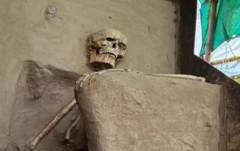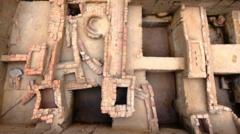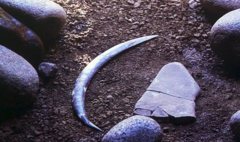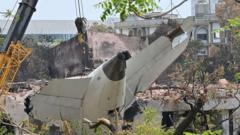A 1,000-year-old human skeleton interred in a seated, cross-legged position in India is languishing without a designated museum, stuck in bureaucratic gridlock even six years after its remarkable discovery. Unearthed in 2019 by archaeologist Abhijit Ambekar in Vadnagar, Gujarat, the skeletal remains were found in a pit, exhibiting a meditative posture that has captivated the attention of historians and archaeologists alike.
Ambekar and his team unearthed the skeletal remains after spotting what appeared to be a human skull while conducting excavations. This intriguing find marks only the fourth instance of such remains found in India, heightening its significance. Currently, the skeleton resides in a temporary tent, amid an ongoing debate among officials regarding its rightful ownership and display.
Ambekar, head of the Archaeological Survey of India (ASI) in Mumbai, estimates the skeleton dates back to the Solanki dynasty, a powerful regime that governed parts of Gujarat from 940 to 1300 CE. Its positioning, with one arm resting on its lap and the other lifted as if holding a stick, offers a glimpse into historical burial practices. "This skeleton is crucial for understanding our ancestral way of life," Ambekar noted.
Despite its importance, the skeleton remains outside a proper facility due to red tape. The Gujarat government had intended for all relics excavated from Vadnagar, which number around 9,000 objects, to be housed in local museums. However, the state claims that proper protocols were not adhered to for the skeleton, thus leaving it in the possession of the ASI.
Ambekar's excavation process was meticulous, lasting about two months as a variety of tools were employed to gently remove soil from around the skeleton, ensuring its preservation. Its current location lacks adequate security and provides minimal protection from environmental threats.
Just a stone's throw away stands a newly constructed Archaeological Experiential Museum, inaugurated with great fanfare in January, which showcases Vadnagar's rich 2,500-year history. While the museum boasts an extensive display of over 5,000 artefacts—ceramics, coins, and tools—it notably does not house the ancient skeleton, which remains curiously absent.
Vadnagar, with archaeological evidence of human settlements tracing back over two millennia, is a site of considerable historical relevance, including remnants of Buddhist monasteries. Ambekar and his team employed DNA analysis and stratigraphic studies to illustrate the skeleton's background, suggesting a local ancestry and dating it to a man in his forties.
The ongoing discussions about enclosing the skeleton in a museum highlight local frustrations over bureaucratic inefficiencies. Residents express a strong desire to properly honor this historical find, fearing that without timely action, the skeleton could suffer further exposure to the elements.
"Why build a museum if the most unique antiquity is left exposed?" questioned Vadnagar resident Jesang Thakor. Locals are united in their hope that proper arrangements will soon be made to transport the ancient remains to an appropriate facility, allowing the skeleton to be preserved and celebrated as a significant artifact of their rich cultural history.





















